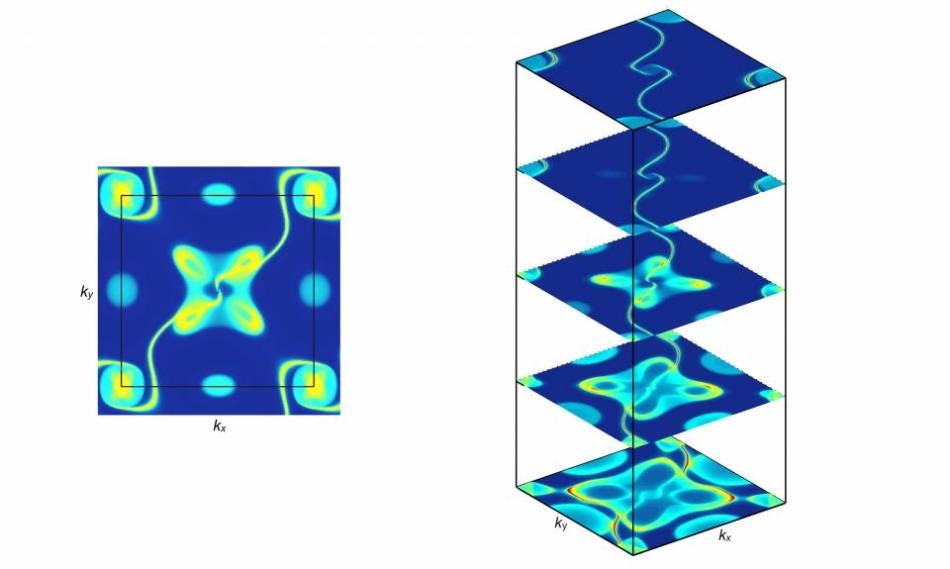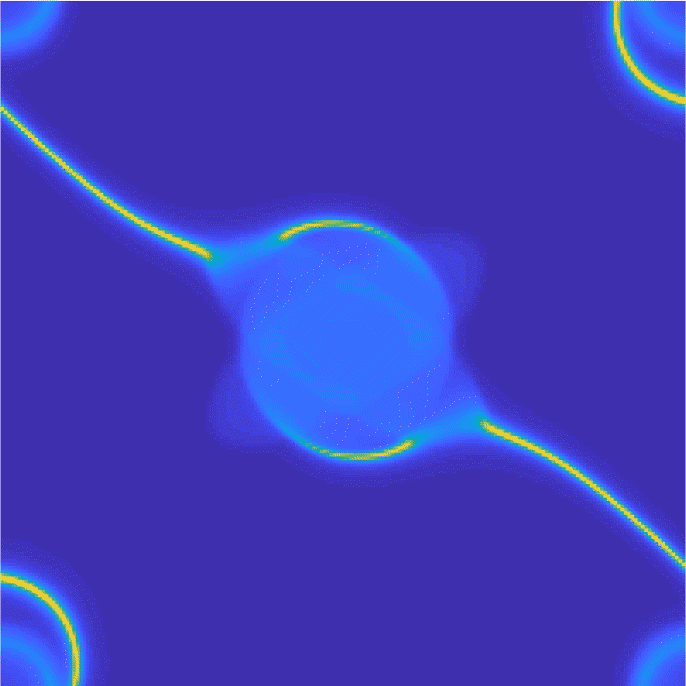Mar 21 2019
An international team of scientists have revealed that specific classes of crystals with an asymmetry like biological “handedness,” called chiral crystals, may contain electrons that act in unpredictable ways.
 (Images by the Hasan Lab, Princeton University)
(Images by the Hasan Lab, Princeton University)
“Before our work, quantum-level properties of electrons in chiral crystals were rarely studied,” said M. Zahid Hasan, the Eugene Higgins Professor of Physics at Princeton University, who led the study. “This decisive work opens up a new continent for explorations in topological materials.”
Also termed as handedness, chirality is a physical property typical to all objects that cannot be superimposed on their mirror image. It can be seen in everyday objects such as gloves, screws, shoes, and multi-level parking garages. Chiral crystals are of significant interest to physicists because of their magnetic, conducting, optical, and particularly their topological properties. Duncan Haldane, Princeton’s Sherman Fairchild University Professor of Physics, won the 2016 Nobel Prize in Physics for his theories envisaging the properties of topological materials.
The topological properties of matter have emerged as one of the most sought-after treasures in modern physics. Both from a fundamental point of view and for finding potential applications in next-generation quantum and nanotechnologies.
M. Zahid Hasan, Study Lead and the Eugene Higgins Professor of Physics, Princeton University.
In an October 2018 article, Hasan’s team proposed a theory that closed the gap between the physical chirality of crystals and how electrons act in those crystals, both quantum mechanically and in keeping with the mathematical laws of topology. The scientists were astonished to learn that all non-magnetic chiral crystals share a common topological quantum property: all of their electronic structures feature band-touching points ruled by the Weyl equation, a quantum equation of motion. Physicist Hermann Weyl projected such behavior of particles while at Princeton in 1929.
Currently, by applying the group theory of crystals, Hasan’s team has established that chiral crystals can host novel forms of Weyl fermions—electrons that collectively act as if they are massless—which they have nicknamed “chiral fermions.” The team applied these concepts to chiral crystals and found unanticipated results concerning their optical, electronic, and topological behaviors, triggering the name “topological chiral crystals.” The scientists were more astonished to discover that these topological chiral crystals can display unique phenomena such as large Fermi arcs and electron spins that collectively act like magnetic monopoles.
Applying their predictive theory, the authors also recognized many high-quality chiral compounds with the prospect for experimental applications. In the middle of them, the rhodium silicides, known collectively as the RhSi class, exhibited the maximum promise, displaying the longest possible topological surface Fermi arcs—a massive energy window for investigating electronic behaviors. Utilizing their groundbreaking method to detect Weyl fermions—which Physics World recognized as one of the Top 10 Breakthroughs of 2015—Hasan and his team started an exploration of electrons in chiral crystals RhSi class some years ago.
They explored the atoms’ arrangement on the surface of the material using a number of methods, such as checking for the correct kind of symmetry using the scanning tunneling microscope in Hasan’s Laboratory for Topological Quantum Matter and Advanced Spectroscopy situated in the basement of Princeton’s Jadwin Hall.
The chiral crystals were then sent to Lawrence Berkeley National Laboratory, where some research members used high energy X-rays to knock electrons off the surface, as examining the patterns made by the released electrons can expose their velocities and masses. The scientists learned that electrons released from deeper within the samples had effectively zero mass, and their velocity and spin distributions showed both their chiral (handed) behavior and their collective monopole-like feature.
“It is amazing to see that somehow the chirality of the crystal structure has a profound effect on the electrons in these materials—they are now massless and chiral,” said Tyler Cochran, a physics graduate student and one of the three co-first authors of the paper.
We expect this is the tip of the iceberg. There are so many chiral crystals in nature. It would be great to check how many of those are topological. This would be a fantastic playground for new types of quantum phenomena.
Ilya Belopolski, Fellow Graduate Student and Co-First Author, Princeton University
“Chiral crystals seem to be a perfect source for novel electronic phases of matter and more excitingly, for the massless electrons of the kind physicists were searching for many years,” said Daniel Sanchez, another co-first author. “This is just terrific that we found them.”
The scientists were thrilled to ascertain this quantum-level chiral behavior of electrons, said Guoqing Chang, a postdoctoral research associate in Hasan’s lab who was the first author of the theory paper predicting these topological occurrences. “It is one of those examples where our theoretical predictions have been realized experimentally,” he said. “That does not always happen. We predicted something new that agreed with what Mother Nature had in store for us—this is just exciting.”
It is indeed immensely satisfying when you predict something exotic and it also appears in the laboratory experiments. This is not the first time we have succeeded in predicting topological effects in quantum physics. We successfully predicted some of the new bismuth-based topological insulators that are now among the mostly studied compounds in the field. We are combining theory and experiments to advance the knowledge frontier.
M. Zahid Hasan, Study Lead and the Eugene Higgins Professor of Physics, Princeton University.
The team included many scientists from Princeton’s Department of Physics, including present and past graduate students Daniel Sanchez, Ilya Belopolski, Tyler Cochran, Nasser Alidoust, Daniel Multer, Songtian Sonia Zhang, Nana Shumiya and Suyang Xu, and present and past postdoctoral research associates Jia-Xin Yin, Guoqing Chang, and Weiwei Xie. Other co-authors were Xitong Xu, Kaustuv Manna, Vicky Süß, Cheng-Yi Huang, Xirui Wang, Guang-Qiang Wang, Tay-Rong Chang, Claudia Felser, Shuang Jia, and Hsin Lin.

This video shows the Fermi arc within topological chiral crystals, moving up and down through the crystal.